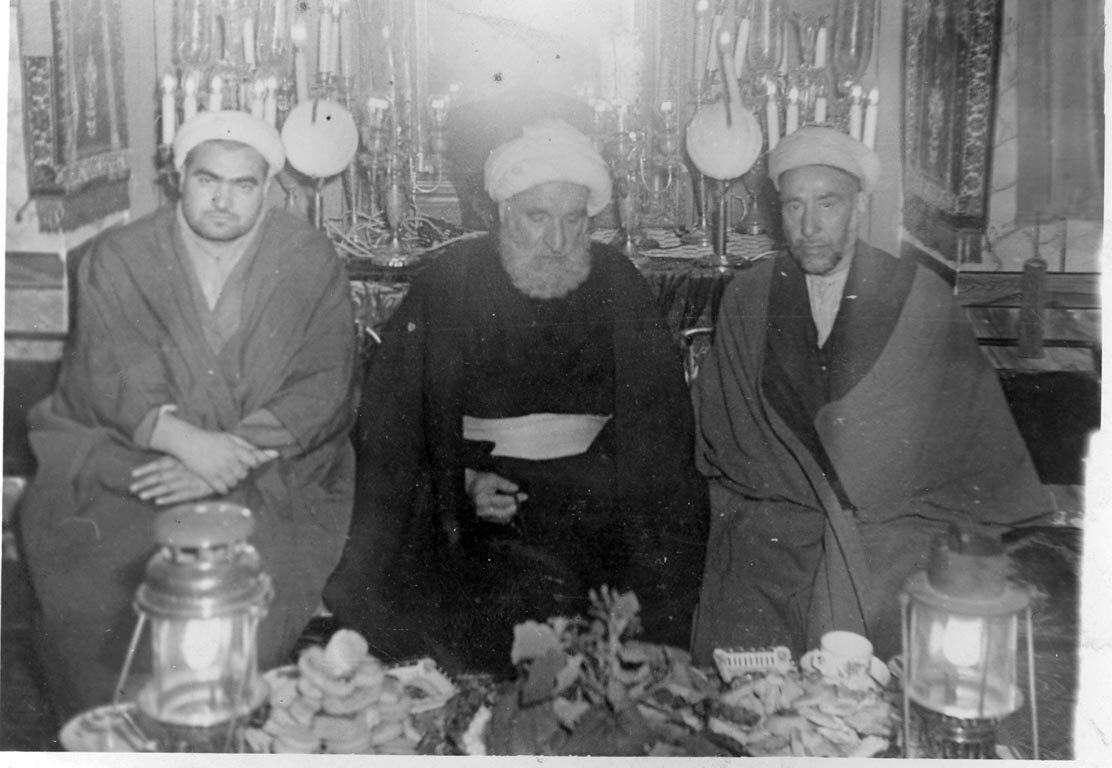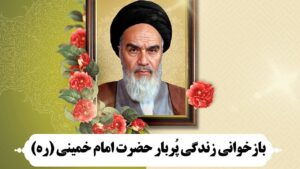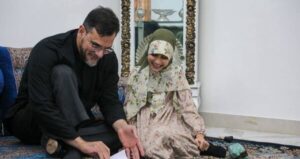to report Missionary thought and culture baseAyatollah Sheikh Hashem Qazvini had a great influence on the students of the Mashhad seminary in terms of morals and knowledge, and he was also an example of the training of the Mashhad seminary in that generation and the flourishing period of this seminary.
The influence of Sheikh Hashem Qazvini on his students was great in terms of moral and science, to the point that according to the leadership, he was an example of Mashhad seminary education in that generation and the flourishing period of this seminary.
The first years of studentship
It was the first years of his studies. Sheikh Hashem, a young student of Isfahan seminary in those days, was going through difficult times. When he was studying in Isfahan, there was a difficult year and sometimes he was very weak from hunger. One day he heard that they were distributing camel meat outside the city. He also went to the other side, and a large number of people stared at the meat dispenser, until finally he got only five servings of that meat.
Sheikh Hashem walked towards the school. On the way, he saw an Armenian woman sitting on the side of an alley, and her two little girls were lying on top of each other like the dead and breathing slowly. The woman, who caught sight of this young student, expressed her need with great weakness and pointed to her two daughters and told her to listen to the cries of her children. Sheikh Hashim was very upset. He went to school and fried the same meats and returned and gave it to that woman. That woman gradually gave those pieces of meat to her daughters and turned her head towards the sky and prayed for her.
He returned to school. While the hot air and the weakness of hunger covered his being, he lay down and had nothing to save himself from hunger. Suddenly, he saw the door of the cell open and a bright old man entered with a bag in his hand. said hello He asked her how she was and said: This is yours. Sheikh Hashem asked: Who sent these? He said: He who has the time in his hands remembers you. He said this and left the room!
Young Sheikh Hashem doubted who this handsome and bright old man was. He followed him but did not see him! He returned to the cell and opened the bag. He saw that Tufton’s breads were fragrant and oily, which he had never seen before. He called some of his friends and narrated the story, and all of them were satisfied and came out of their weakness.
This young Qazvini student left for Mashhad in the following years and by participating in the lessons of great people, such as Mirza Mohammad Aghazadeh, the son of Akhund Khorasani, and Haj Agha Hossein Qomi, he attained the degree of ijtihad.
Birth and birthplace
The late Ayatollah Haj Sheikh Hashim Qazvini was born in 1270 solar year in the village of Qaleh Hashem Khan Qazvin in a well-known farmer’s family. From his childhood, he was raised and developed with love and affection for Ahl al-Bayt (A.S.), so that he observed the obligatory duties and abstaining from taboos from that time.

Education and professors
He learned the basics and literature in Qazvin and after completing Arabic literature, he studied high levels of jurisprudence and principles in the presence of Qazvin professors, headed by Haj Mullah Ali Tarimi and Akhund Mullah Ali Akbar. He studied the philosophy of Ishrak and Masha from the late Ayatollah Haj Seyyed Musa Zarabadi Qazvini. After that, he went to Isfahan to complete his higher education degrees, where he studied with the late Kolbasi and Shaharaki, and after six years of residence, he returned to Qazvin.
During this period, he heard the description of Mashhad Seminary, which was considered to be the leading scientific community at that time, and the nature of his research made him want to migrate to this system. In his eagerness to reach this center of knowledge, he traveled a lot.
In Mashhad, he studied the verses of Haj Agha Hossein Qomi and Mirza Mohammad Aghazadeh Khorasani (son of Akhund Mullah Mohammad Kazem Khorasani, owner of Kefayeh) and was honored with the permission of ijtihad from the latter two masters, and this same permission was signed by Grand Ayatollah Seyed Abulhasan Isfahani. Sadr an ahlah wa waqah fi mahalla” was clarified. After returning from Iraq, with the migration of Ayatollah Mirza Mahdi Esfahani to Mashhad in 1340 A.H., he benefited from his presence for a while and learned the principles of Mirza Nayini from him.
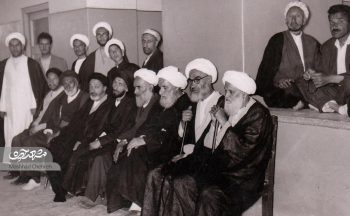
A strong mountain against Pahlavi tyranny
Reza Khan Mirpanj came to power and according to colonial planning, he issued a directive to achieve his nefarious goals, and that was the use of Pahlavi or Shapo hats by all Iranian people, in such a way that no one had the right to appear in society without a hat or with local hats. .
The great scholars of Mashhad, such as Ayat Haj Agha Hossein Qomi, Haj Mirza Mohammad Aghazadeh, Sheikh Hashim Qazvini, Seyyed Ali Sistani and Seyyed Ali Akbar Khoei gathered at the house of Hazrat Ayatollah Seyed Yunus Ardebili and important decisions were made, including writing a telegram to the king and warning To him that these plans are not applicable in Islamic Iran and he should give up his decision.
At the discretion of the gentlemen, it was decided that Ayatollah Haj Agha Hossein Qomi would deliver the telegram to the Shah and convince him to abandon his plans. The people present at the meeting, including Madras Qazvini, signed the telegram and expressed their clear opposition to the colonial plans.
Haj Agha Hossein Qomi was surrounded and exiled to Atbat by the Shah’s order after reaching the city of Ray. After the tragedy of Goharshad mosque, the scholars who telegraphed to Reza Khan were arrested and sent to prison, and after a while they were all exiled to different cities.
After two months of trial of the great scholars of Ardabil, Shiraz, Shahroud, Qazvin, etc., the Pahlavi government decides to exile them. According to their signature in the telegram, one was exiled to Shiraz, the other to Ardabil, and Ayatollah Haj Sheikh Hashem was exiled to Qazvin, until in September 1320, due to the events of World War II and the occupation of Iran by foreign forces, the Taghut regime was overthrown and Reza Shah was sent to the island of Mauritius. He was exiled in Africa. He returned to the holy city of Mashhad and stayed nearby and taught and trained students in this city until the end of his life.
Sheikh Hashem’s relationship with Mirza was very close and even though Sheikh Hashem was in the position of ijtihad, until the last years of Mirza Mahdi Isfahani’s life, he gained favor from him.
Kingdom Ascension
Finally, the high-ranking teacher of Mashhad seminary, that great scholar, after 69 years of blessed life, forty years of teaching and training outstanding and pious students, died on the 22nd of October 1339 at the same time as the 20th of Rabi-ul-Akhr 1381. He was buried from the north side of Azadi shoe shop number 7.
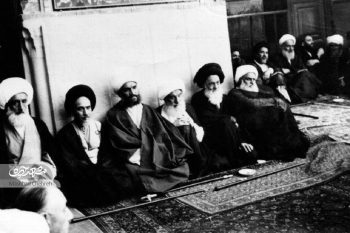
The leader of the revolution and a student of Sheikh Hashem Qazvini for many years
Mashhad seminary has witnessed the growth and development of great thinkers for a long time. In the contemporary period, several personalities shone like the sun on the desert of Khorasan. Ayatollah Sheikh Hashem Qazvini was one of these great scholars of this city and country.
The supreme leader of the revolution was one of the students of this innovative jurist and participated in his jurisprudence, principles and ethics lessons. The influence of Sheikh Hashem on his students was great in terms of moral and science. The supreme leader of the revolution says in this regard: “The late Agha Haj Sheikh Hashem (may God bless him and grant him peace) was actually an example of Mashhad seminary education in that generation and the flourishing period of this seminary in the period before us. His comprehensiveness is rare.”
After passing the level lessons, His Holiness went to Sheikh Hashem Qazvini to continue his journey at higher levels. They say about this: “We were students of the late Haj Sheikh Hashem for many years, and we used to go to the lessons of Makasab and Rasail, and then Kefaye. At the end of our stay in Mashhad, before Qom, he started studying abroad. A few mornings, I went to study abroad. He was a great mullah and jurist of Mobarzi and among the prominent students of the late Aghazadeh, the son of Akhund. That is, in the ranks of people like Sheikh Agha Bozor Shahroudi and the late Agha Mirza Hassan Bajnorudi and these elders who left Mashhad and later became famous in Najaf, Haj Sheikh Hashem was considered among them. They kept him in Mashhad.”
After the presence of Mirza Mehdi Esfahani in Mashhad, the scientific atmosphere of this city underwent a tremendous transformation. Before this, the foundations of Akhund Khorasani were mentioned by the scholars, but Mirza, with his proposal of the foundations of Mirza Nayini, caused a new look to be introduced to jurisprudence and principles.
The Supreme Leader of the Revolution describes this period as follows: “Before the late Mirzai Isfahani came to Mashhad, the scientific atmosphere of Mashhad was the atmosphere of Khorasani Mukhtar. Later, when the late Mr. Mirza Mahdi Esfahani came to Mashhad from Najaf, he brought the words of the late Nayini into the field, and those broad foundations and this work and those new words of the late Mr. Nayini in Usul, which are often related to the statements of the late Mr. Akhund, are discussed in Mashhad. It is possible, and the good people gradually gather around him, and the lessons of his principles are flourishing. The late Haj Sheikh Hashem, in addition to being a scholarly friend of the late Agha Mirza Mahdi, also became his promoter, and I think the attraction of the late Mirza kept him in Mashhad.

An attractive and effective statement
Sheikh Hashem Qazvini had an attractive and effective speech and his lessons were held with enthusiastic attendance of students. His Holiness also considered one of the important characteristics of the Sheikh to be his expressiveness. They say: “One of his characteristics was extraordinary expression.
In the year 1336, I became the governor of Najaf. I attended all the famous courses in Najaf. Then we came to Qom. In 2013, I also attended 13 classes in Qom. I did not see anyone as optimistic as Haj Sheikh Hashem; An eloquent expression, a suitable and warm voice for teaching. Another characteristic of him was mastering the basics of textbooks. When he was teaching Makasab from those old books, half a page or more every day, he would read a few sentences of the phrase. Then he would close the book and explain the whole thing. All the contents were present in his mind and he mastered the benefits and messages and so on. Another point that existed in him was the moral aspect of this man. This man was spiritually and morally good, a student of Mr. Mirza Mehdi; It means that he was really well-groomed. Sometimes his words of advice would open up in the lesson, he would advise the students, and the students would cry. At the same time, he made jokes in class.”
Sheikh Hashem Qazvini was famous among his students for being clear-minded and up-to-date. This characteristic had caused his students to follow this policy. The supreme leader of the revolution, who himself is one of those who have been greatly influenced by his master, says: “Another characteristic of him was his clear thinking. We also saw this in the late Haj Sheikh Mojtabi Qazvini. At that time, reading newspapers and magazines among students and scholars was not common.
They did not think at all. A certain amount was considered a defect. I mean, really, if a student got a newspaper at school, especially if it was a magazine that usually had pictures of topless women on the back of the magazine, it would be really considered a big shame. In this space, the late Sheikh Hashem used to buy a magazine on his way back from the shrine. He was a handsome man. Man did not dare to greet him, he had enough dignity and awe.
At the same time, he was so humble with the student, he would answer the question he asked with complete kindness. He was a very zealous man. When it was forbidden to pray in the holy shrine, a servant insulted them and told them not to pray here! The first Sheikh did not pay attention. Then Khadim had planned to bully Haj Sheikh.
Haj Sheikh had picked up his deceased from the ground with one hand and with the other hand he slapped this servant and came out of the shrine. Of course, they returned them with respect. This brave and zealous man treated weak students with complete kindness. When he died, we were in Qom, the late Ayatollah Boroujerdi held an elaborate assembly for him in the Fayzieh Madrasah, and scholars and elders participated.”
During the period when Nawab Safavi was engaged in revolutionary activities, some scholars opposed his activities, but Sheikh Hashim Qazvini was one of those who considered his revolutionary outlook useful for the struggle. After the death sentence was given to Nawab in the Taghut court, Sheikh Hashem expressed his negative opinion about this sentence to his students.
The supreme leader of the revolution says in this regard: “The late Ayatollah Qazvini was the only cleric who reacted to the martyrdom of the late Nawab Safavi based on his freedom and magnanimity, and he strongly criticized the martyrdom of the late Nawab Safavi and his associates in the parliament, and the conspiracy of the ruling apparatus and his own influence. expressed their martyrdom and said: “Our country has reached the point where they kill the Prophet’s son for the crime of telling the truth!”
* Sources: Mashhadchehra, Wiki Shia, Wiki Fiqh
منبع: www.khabaronline.ir

